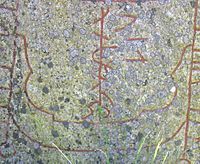Bind rune

A bind rune or bindrune (Icelandic: bandrún) is a Migration Period Germanic ligature of two or more runes. They are extremely rare in Viking Age inscriptions, but are common in earlier (Proto-Norse) and later (medieval) inscriptions.[1]
On some runestones, bind runes may have been ornamental and used to highlight the name of the carver.[2]
Description
[edit]There are two types of bind runes. Normal bind runes are formed of two (or rarely three) adjacent runes which are joined together to form a single conjoined glyph, usually sharing a common vertical stroke (see Hadda example below).[3] Another type of bind rune called a same-stave rune, which is common in Scandinavian runic inscriptions but does not occur at all in Anglo-Saxon runic inscriptions, is formed by several runic letters written sequentially along a long common stemline (see þ=r=u=t=a=ʀ= =þ=i=a=k=n example shown in image).[4] In the latter cases the long bind rune stemline may be incorporated into an image on the rune stone, for example as a ship's mast on runestones Sö 158 at Ärsta and Sö 352 in Linga, Södermanland, Sweden, or as the waves under a ship on DR 220 in Sønder Kirkeby, Denmark.[4]
Examples
[edit]Elder futhark
[edit]Examples found in Elder Futhark inscriptions include:
- Stacked Tiwaz runes: Kylver Stone, Seeland-II-C
- Gebô runes combined with vowels: Kragehul I
- The syllable ing written as a ligature of Isaz and Ingwaz (the so-called "lantern rune").[5]
Anglo-Saxon Futhorc
[edit]Bind runes are not common in Anglo-Saxon inscriptions, but double ligatures do sometimes occur, and triple ligatures may rarely occur. The following are examples of bind-runes that have been identified in Anglo-Saxon runic inscriptions:[6][7]


- The word gebiddaþ is written with a ligatured double ᛞ (dd) on the Thornhill III rune-stone
- The name Hadda is written with a ligatured double ᛞ (dd) on the Derbyshire bone plate
- The word broþer is written with a ligatured ᛖ and ᚱ (er) on some Northumbrian stycas
- The Latin word meus is written as mæus with a ligatured ᛗ and ᚫ (mæ) on the Whitby comb
- The inscription [h]ring ic hatt[æ] ("ring I am called") is written with a ligatured ᚻ and ᚪ (ha) on the Wheatley Hill finger-ring
- The names of the evangelists, Mat(t)[h](eus) and Marcus are both written with a ligatured ᛗ and ᚪ (ma) on St Cuthbert's coffin
- The name Dering may be written with a triple ligatured ᛞ, ᛖ and ᚱ (der) on the Thornhill III rune-stone (this reading is not certain)
- The word sefa is written with a ligatured ᚠ and ᚪ (fa) on the right side of the Franks Casket
- Double ligatured runes ᛖᚱ (er), ᚻᚪ (ha) and ᛞᚫ (dæ) occur in the cryptic runic inscription on a silver knife mount at the British Museum
- The word gægogæ on the Undley bracteate is written with ligatured ᚷ and ᚫ (gæ) and ᚷ and ᚩ (go)
- A ligatured ᚾ and ᛏ (nt) occurs in the word glæstæpontol on a cryptic inscription on a silver ring from Bramham Moor in West Yorkshire
- A triple ligature ᛞ, ᛗ and ᚩ (dmo) occurs on a broken amulet found near Stratford-upon-Avon in 2006. This is the only known certain Anglo-Saxon triple bind rune. There is possibly a faint ᛖ, ᛞ (ed) bind rune on the reverse of the amulet.[8]
- The name Ecgbeorht engraved on an armband from the Galloway Hoard is written eggbrect with ligatured ᛖ and ᚳ (ec), and the final ᛏ (t) added above the final letter
- The otherwise unattested Anglo-Saxon name Eadruf ᛖᚪᛞᚱᚢᚠ is inscribed on a gold Latin cross pendant, with ligatured ᛞ and ᚱ (dr) and probable ligatured ᛖ and ᚪ (ea)[9]
Modern use
[edit]- The Bluetooth logo
 merges the runes analogous to the modern Latin alphabet letters h and b; ᚼ (Hagall) and ᛒ (Berkanan) together, forming a bind rune. The two letters form the initials 'H B', alluding to the Danish king and viking raider Harald Bluetooth, for whom Bluetooth was named.
merges the runes analogous to the modern Latin alphabet letters h and b; ᚼ (Hagall) and ᛒ (Berkanan) together, forming a bind rune. The two letters form the initials 'H B', alluding to the Danish king and viking raider Harald Bluetooth, for whom Bluetooth was named. - The former logo of Thor Steinar featured a combination of a *tiwaz rune (ᛏ) and a *sowilo rune ᛋ. This logo caused controversy as the runes were so combined that a part of the logo became very similar to the insignia of the Schutzstaffel.
Gallery
[edit]-
The a and the þ runes in ligature on the Rök runestone
-
The s and k runes in ligature in the Old Norse word skipari ("sailor") on the Tuna Runestone in Småland
-
A bind rune for the word runaʀ on the Sønder Kirkeby Runestone in Denmark
See also
[edit]References
[edit]- ^ Enoksen, Lars Magnar (1998). Runor: historia, tydning, tolkning, p. 84. Historiska Media, Falun. ISBN 91-88930-32-7
- ^ MacLeod, Mindy (2006), "Ligatures in Early Runic and Roman Inscriptions", in Stocklund, Marie; et al. (eds.), Runes and Their Secrets: Studies in Runology, Copenhagen: Museum Tusculanum Press, p. 194, ISBN 87-635-0428-6
- ^ Elliott, R. W. V. (1980). Runes. Manchester University Press. p. 22. ISBN 0-7190-0787-9.
- ^ a b MacLeod, Mindy (2002). Bind-Runes: An Investigation of Ligatures in Runic Epigraphy. Uppsala University. pp. 16–18, 158–59, 162–163. ISBN 91-506-1534-3.
- ^ Richard Lee Morris, Runic and Mediterranean Epigraphy, 1988, p. 130.
- ^ Elliott, R. W. V. (1980). Runes. Manchester University Press. pp. 87, 105. ISBN 0-7190-0787-9.
- ^ Page, Raymond I. (2006). An Introduction to English Runes. Boydell Press. pp. 48, 163, 169, 172. ISBN 0-85115-946-X.
- ^ "Amulet WAW-4CA072". Portable Antiquities Scheme. 6 September 2010. Retrieved 2013-01-06.
- ^ "Penndant DUR-B62F57". Portable Antiquities Scheme. 23 June 2020. Retrieved 2021-01-10.




